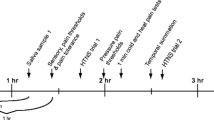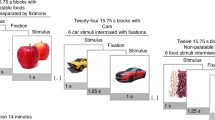Abstract
The contribution of central and peripheral sites to opioid mediation of energy intake and dietary self-selection of the three macronutrients, protein, fat, and carbohydrate, was examined in male rats. Animals given access to either Purina Chow or a self-selection regime were injected with either the opioid antagonist, naltrexone (0.0, 0.1, 1.0, and 5.0 mg/kg, IP), or quarternary naltrexone (0.0, 0.1, 1.0, and 5.0 mg/kg, IP), an opioid antagonist that does not readily enter the central nervous system. Animals received injections at the beginning of an 8-h feeding period, and nutrient intakes were measured at 1, 2, 4, and 8 h postinjection. Naltrexone and its quarternary analogue differed in their effects both on total energy intake and macronutrient selection. Naltrexone led to significant decreases in total energy intake in animals on both dietary regimes, whereas quarternary naltrexone did not modify energy intake of animals given access to either diet. Naltrexone produced a sustained reduction in fat intake and initial decreases in carbohydrate and protein intakes. Quarternary naltrexone did not modify overall energy intake but did lead to modifications in nutrient choice. In contrast to naltrexone, quarternary naltrexone resulted in increased fat intake, decreased carbohydrate intake, and a small reduction in protein intake. These data suggest that both peripheral and central sites contribute to opioid effects on patterns of nutrient choice.
Similar content being viewed by others
References
Brown DR, Holtzman SG (1981) Opiate antagonists: Central sites of action in suppressing water intake of the rat. Brain Res 221:432–436
Bruni JF, VanVugt D, Marshall S, Meites J (1977) Effects of naloxone, morphine and methionine enkephalin on serum prolactin, luteinizing hormone, follicle stimulating hormone, thyroid stimulating hormone and growth hormone. Life Sci 21:461–466
Bruni J, Watkins W, Yen S (1979) β-Endorphin in the human pancreas. J Clin Endocrinol Metab 49:649–651
Carr KD, Simon EJ (1983) Effects of naloxone and its quarternary analogue on stimulation-induced feeding. Neuropharmacology 22:127–130
Cooper SJ (1980) Naloxone: Effects on food and water consumption in non-deprived and deprived rats. Psychopharmacology 71:1–6
Cooper SJ, Turkish S (1983) Effects of naloxone and its quaternary analogue on fluid consumption in water-deprived rats. Neuropharmacology 22:797–800
de Castro JM, Paulin K, DeLugas GM (1978) Insulin and glucagon as determinants of body weight set point and microregulation in rats. J Comp Physiol Psychol 92:571–594
Feldman M, Kiser RS, Unger RH, Li CH (1983) β-Endorphin and the endocrine pancreas. N Engl J Med 308:349–353
Frenk H, Rogers GH (1979) The suppressant effects of naloxone on food and water intake in the rat. Behav Neural Biol 26:23–40
Grandison L, Guidotti A (1977) Stimulation of food intake by muscimol and β-endorphin. Neuropharmacology 16:533–536
Grube D, Voigt KH, Weber E (1978) Pancreatic glucagon cells contain endorphin-like immunoreactivity. Histochemistry 59:75–79
Holtzman SG (1974) Behavioral effects of separate and combined administration of naloxone and d-amphetamine. J Pharmacol Exp Ther 189:51–60
Holtzman SG (1979) Suppression of appetitive behavior in the rat by naloxone: Lack of effect of prior morphine dependence. Life Sci 24:219–226
Ipp E, Dobbs R, Unger RH (1978) Morphine and β-endorphin influence the secretion of the endocrine pancreas. Nature 276:190–191
Jacobs HL (1958) Studies on sugar preference. I. The preference for glucose solutions and its modification by injections of insulin. J Comp Physiol Psychol 51:304–309
Jalowiec JE, Panksepp J, Zolovick AJ, Najam N, Herman BH (1981) Opioid modulation of ingestive behavior. Pharmcol Biochem Behav 15:477–484
Jones JG, Richter JA (1980) Studies of the site of action of naloxone in suppressing food and water intake in rats. Soc Neurosci Abs 6:528
Kanarek RB, Marks-Kaufman R, Lipeles BJ (1980) Increased carbohydrate intake as a function of insulin administration in rats. Physiol Behav 25:779–782
Kumar R, Mitchell E, Stolerman IP (1971) Disturbed patterns of behavior in morphine-tolerant and abstinent rats. Br J Pharmacol 42:473–484
Margules DL, Moisset B, Lewis MJ, Shibuya H, Pert CB (1978) β-Endorphin is associated with overeating in genetically obese mice (ob/ob) and rats (fa/fa). Science 202:988–991
Marks-Kaufman R (1982) Increased fat consumption induced by morphine administration in rats. Pharmacol Biochem Behav 16:949–955
Marks-Kaufman R, Kanarek RB (1980) Morphine selectively influences macronutrient intake in the rat. Pharmacol Biochem Behav 12:427–430
Marks-Kaufman R, Kanarek RB (1981) Modifications in nutrient selection induced by naloxone in rats. Psychopharmacology 74:321–324
Marks-Kaufman R, Lipeles BJ (1982) Patterns of nutrient selection in rats orally self-administering morphine. Nutr Behav 1:33–46
McKay LD, Kenney NJ, Edens NK, Williams RH, Woods SC (1981) Intracerebroventricular β-endorphin increases food intake of rats. Life Sci 24:1429–1434
Meites J, Bruni JF, Van Vugt DA, Smith AF (1979) Relation of endogenous opioid peptides and morphine to neuroendocrine functions. Life Sci 24:1325–1336
Morley JE, Levine AS, Yim GK, Lowy MT (1983) Opioid modulation of appetite. Neurosci Biobehav Rev 7:281–305
Polak JM, Bloom S, Sullivan S, Facer P, Pearse A (1977) Enkephalin-like immunoreactivity in the human gastrointestinal tract. Lancet 1:972–974
Richter CP (1942) Increased dextrose appetite of normal rats treated with insulin. Am J Physiol 135:781–787
Sanger DJ, McCarthy PS (1981) Increased food and water intake produced in rats by opiate receptor agonists. Psychopharmacology 74:217–220
Shaar CJ, Frederickson RCA, Dininger NB, Jackson L (1977) Enkephalin analogues and naloxone modulate the release of growth hormone and prolactin — Evidence for regulation by an endogenous peptide in brain. Life Sci 21:853–860
Tepperman FS, Hirst M (1982) Concerning the specificity of the hypothalamic opiate receptor responsible for food intake in the rat. Pharmacol Biochem Behav 17:1141–1144
Tepperman FS, Hirst M, Gowdey CW (1981) Hypothalamic injection of morphine: Feeding and temperature responses. Life Sci 28:2459–2467
Thornhill JA, Taylor B, Marshall W, Parent K (1982) Central, as well as peripheral, naloxone administration suppresses feeding in food-deprived Sprague-Dawley and genetically obese (Zucker) rats. Physiol Behav 29:841–846
Valentino RJ, Herling S, Woods JH, Medzihradsky F, Merz H (1981) Quarternary naltrexone: Evidence for the central mediation of discriminative stimulus effects of narcotic agonists and antagonists. J Pharmacol Exp Ther 217:652–659
Yim GKW, Lowy MT, Holsapple, Nichols MB (1980) Peripheral mediation of opiate effects on feeding in rats. Soc Neurosci Abs 6:528
Author information
Authors and Affiliations
Rights and permissions
About this article
Cite this article
Marks-Kaufman, R., Plager, A. & Kanarek, R.B. Central and peripheral contributions of endogenous opioid systems to nutrient selection in rats. Psychopharmacology 85, 414–418 (1985). https://doi.org/10.1007/BF00429656
Received:
Accepted:
Issue Date:
DOI: https://doi.org/10.1007/BF00429656




